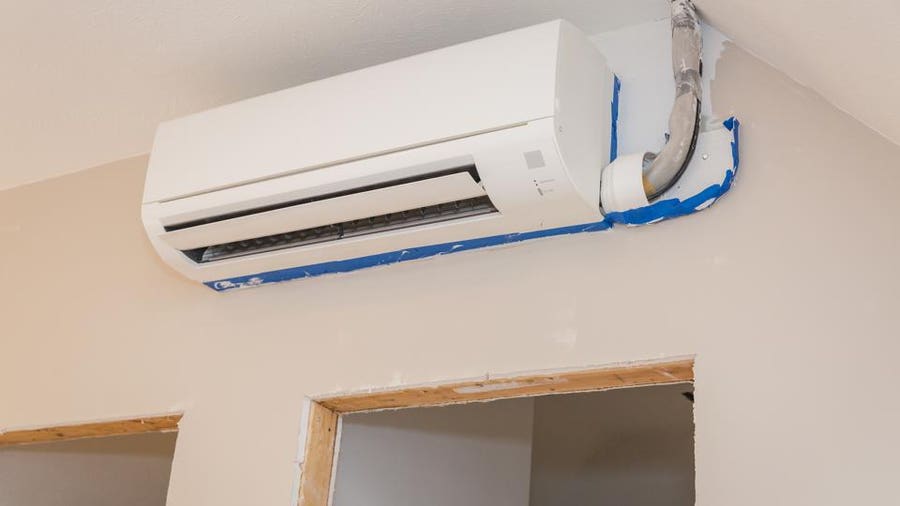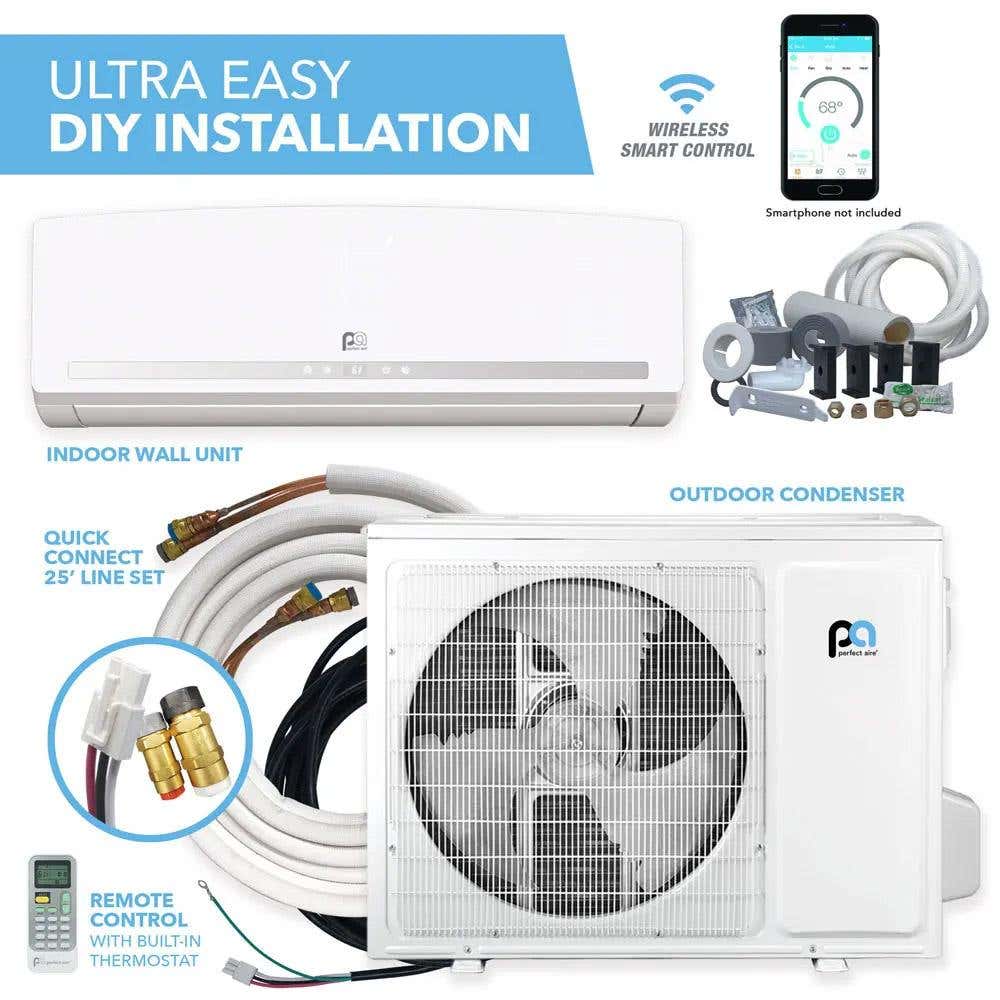Have you ever considered installing a mini split system in your home but weren’t sure if you could tackle the installation yourself? In this article, we explore the pros and cons of DIY mini split installation and whether or not it’s worth the potential savings. From the satisfaction of completing the project on your own to the potential risks involved, let’s take a closer look at this popular trend in home cooling and heating.

This image is property of images.squarespace-cdn.com.
Understanding Mini Split Systems
What is a mini split system?
A mini split system, also known as a ductless HVAC system, is a type of heating and cooling system that does not require ductwork. It consists of an outdoor unit and one or more indoor units, connected by refrigerant lines. These systems are becoming increasingly popular for their versatility and energy efficiency.
How does a mini split system work?
Mini split systems work by using refrigerant to transfer heat between the indoor and outdoor units. The outdoor unit contains a compressor and a condenser, which extract heat from the outside air. The indoor units, usually mounted on the wall or ceiling, release the heated or cooled air into the desired space. The refrigerant circulates through the system, absorbing and releasing heat as needed.
Common uses and benefits of mini split systems
Mini split systems are commonly used in residential and commercial spaces that do not have existing ductwork, such as older homes or room additions. They are also popular in multi-family buildings and office spaces. Some of the benefits of mini split systems include energy efficiency, zoning capabilities, easy installation, and the ability to control the temperature in individual rooms or zones.
Cost Considerations for DIY Mini Split Installations
Comparing DIY and professional installation costs
One of the main reasons homeowners consider DIY mini split installations is the potential cost savings. While the cost of professional installation can vary depending on factors such as the size of the system and the complexity of the installation, it generally includes labor, materials, and any necessary permits. DIY installations, on the other hand, often only require the cost of the equipment and any additional tools or materials needed.
Hidden costs of DIY installations
While DIY installations may seem like a way to save money, there are some hidden costs to consider. These can include the time spent researching and learning about the installation process, the potential for errors that may require professional intervention and additional costs, and any equipment or tools that may need to be purchased in order to complete the installation.
Potential savings in DIY mini split installations
Despite the potential for hidden costs, DIY mini split installations can still offer substantial savings compared to professional installations. By eliminating labor costs, homeowners can save a significant amount of money. Additionally, the ability to control the pace of the project and purchase materials at their own convenience can make DIY installations more cost-effective for some individuals.
Pros of DIY Mini Split Installations
Saving on labor costs
One of the most obvious benefits of a DIY mini split installation is the ability to save on labor costs. By taking on the task yourself, you can eliminate the expense of hiring a professional, which can often be a significant portion of the overall cost of the project. This can make DIY installations particularly appealing for those who are working with a tight budget.
Learning new skills
Another advantage of a DIY mini split installation is the opportunity to learn new skills. Taking on a project like this can be a great way to gain a better understanding of how HVAC systems work and how to install and maintain them. This knowledge can be valuable not only for future DIY projects but also for basic troubleshooting and maintenance of your mini split system.
Controlling the pace and scheduling of the project
When you choose to install a mini split system DIY, you have the freedom to control the pace and scheduling of the project. You can work at your own speed, starting and stopping as needed, which can be particularly beneficial if you have a busy schedule. This flexibility allows you to complete the installation on your own terms, without having to work around the availability of a professional installer.
Cons of DIY Mini Split Installations
Potential for errors and their costs
One of the main disadvantages of a DIY mini split installation is the potential for errors. HVAC systems can be complex, and even a small mistake can have costly consequences. Improper installation can lead to inefficiency, poor performance, or even damage to the system. In these cases, homeowners may need to bring in a professional to correct the problem, resulting in additional expenses.
Time consuming
DIY mini split installations can be time-consuming. In addition to the time spent researching and learning about the installation process, homeowners will also need to dedicate significant time to actually complete the installation. Depending on the complexity of the project, this can range from a few hours to multiple days or even weeks. This time commitment is something that homeowners should consider, especially if they have other obligations or time-sensitive projects.
Risk of injury
Installing a mini split system can involve working with electrical components and climbing ladders or working at heights. This can increase the risk of injury, particularly for those without experience in these areas. While safety precautions can minimize the risk, accidents can still happen. Homeowners should carefully assess their comfort level with these tasks and consider their own physical abilities before attempting a DIY installation.
Possibility of voiding warranty
Most mini split systems come with manufacturer warranties that may require professional installation in order to remain valid. Attempting a DIY installation can potentially void these warranties, leaving homeowners responsible for any future repairs or replacements. It is important to carefully review the warranty terms and consider the impact a DIY installation may have before proceeding.

This image is property of www.youngshomecomfort.com.
Skills Needed for DIY Mini Split Installation
Understanding technical instructions
A DIY mini split installation requires the ability to understand and follow technical instructions. This includes reading and interpreting installation manuals, wiring diagrams, and other technical documents. It is important to have a good grasp of these instructions to ensure the system is installed correctly and safely.
Basic HVAC knowledge
Having a basic understanding of HVAC systems is crucial when attempting a DIY mini split installation. This includes knowledge of how heating and cooling systems work, as well as familiarity with common HVAC terminology and components. This knowledge will help homeowners navigate the installation process and troubleshoot any issues that may arise.
Electrical skills
A DIY mini split installation involves working with electrical components, such as wiring and connectors. It is important to have a basic understanding of electrical safety and the ability to properly install and connect electrical components. If homeowners are not comfortable or experienced in working with electricity, it may be best to hire a professional to ensure a safe and proper installation.
Problem-solving ability
Installing a mini split system can present challenges and unexpected issues. Homeowners undertaking a DIY installation should have problem-solving skills to tackle these challenges and find solutions. This includes the ability to think creatively, troubleshoot problems, and make adjustments as necessary to ensure a successful installation.
Tools Required for DIY Mini Split Installation
Basic tools requirement
A DIY mini split installation will require a basic set of tools, including a drill, screwdriver set, wrenches, and a level. These tools are commonly found in most households and are essential for tasks such as mounting the indoor unit, connecting electrical components, and securing the outdoor unit.
Specialized HVAC tools
In addition to basic tools, a DIY mini split installation may also require specialized HVAC tools. These can include refrigerant gauges, tubing cutters, flare tools, and vacuum pumps. While these tools may not be necessary for all installations, they can greatly facilitate the process and ensure a professional-grade installation.
Safety gear
When performing a DIY mini split installation, it is important to prioritize safety. This includes wearing appropriate safety gear such as gloves, safety glasses, and ear protection. Additionally, when working with electrical components or on rooftops, fall protection equipment may be necessary. Safety should always be the top priority when working on a DIY installation.

This image is property of thumbor.forbes.com.
Common Mistakes in DIY Mini Split Installation
Incorrect sizing
One of the most common mistakes in DIY mini split installations is incorrect sizing. HVAC systems need to be properly sized to ensure they can effectively heat or cool the desired space. Overly small units may struggle to maintain the desired temperature, while units that are too large can lead to short cycling and inefficiency. Proper sizing requires careful calculations and consideration of factors such as insulation, square footage, and climate.
Poor placement of components
Another common mistake in DIY installations is poor placement of components. The indoor unit should be strategically placed to optimize airflow in the room, while the outdoor unit should be located in a well-ventilated area that is free from obstructions. Failing to properly place these components can result in inefficient operation and poor performance.
Ignoring local codes and permits
DIY mini split installations, like any other HVAC work, must comply with local codes and regulations. This includes obtaining any necessary permits and following specific guidelines for installation. Ignoring these requirements can result in penalties or having to redo the installation to meet the standards.
Failure to properly charge the system
Properly charging the refrigerant in a mini split system is essential for optimal performance. DIY installers may overlook the importance of this step or may not have the necessary equipment to accurately charge the system. Incorrect refrigerant levels can lead to reduced efficiency and performance, as well as potential damage to the system.
Professional Installation and Its Benefits
Guarantee of proper installation
One of the main benefits of professional installation is the guarantee of a proper installation. Experienced HVAC professionals have the knowledge and expertise to ensure that the system is correctly sized, components are properly placed, and all wiring and connections are done accurately. This can provide peace of mind knowing that the system will function efficiently and effectively.
Time-saving
Professional installation can save homeowners significant time and effort. HVAC professionals are experienced in installing mini split systems, which means they can complete the installation quickly and efficiently. This is particularly beneficial for those who have a busy schedule or other time-sensitive projects.
Compliance with local codes and standards
HVAC professionals are well-versed in local codes and regulations. They understand the requirements for permits, inspections, and proper installation procedures. Hiring a professional ensures that the installation is done in accordance with these standards, reducing the risk of penalties or the need for costly corrective measures.
Continued maintenance and support
When homeowners choose professional installation, they often have access to continued maintenance and support from the HVAC company. This can include regular maintenance and tune-ups, as well as assistance with any issues that may arise. Having this ongoing support can help extend the lifespan of the system and ensure optimal performance.

This image is property of media.angi.com.
Deciding Between DIY and Professional Installation
Assessing one’s own skills and comfort level
When deciding between DIY and professional installation, it is important to realistically assess one’s own skills and comfort level. DIY installations require a certain level of technical knowledge and hands-on abilities. If homeowners are not confident in their skills or feel uncomfortable with the tasks involved, it may be best to hire a professional to ensure a successful installation.
Weighing time commitment versus potential savings
Another factor to consider is the time commitment versus potential savings. DIY installations can be time-consuming, especially for those with limited experience. Homeowners should evaluate whether the potential savings outweigh the amount of time and effort required for a DIY installation. If time is a more valuable resource, professional installation may be the better choice.
Considering the long-term investment
Mini split systems are a long-term investment in the comfort and efficiency of a home. It is important to consider the potential long-term impact of DIY versus professional installation. While DIY installations may offer immediate cost savings, professional installations can ensure proper performance and longevity of the system. Homeowners should weigh the short-term savings against the potential long-term benefits and make an informed decision based on their individual circumstances.
Conclusion: Is DIY Mini Split Installation Worth The Savings?
In conclusion, DIY mini split installation can be an appealing option for those looking to save on labor costs and take on a new challenge. It offers the opportunity to learn new skills and work at your own pace. However, there are also potential drawbacks, such as the possibility of errors and the risk of voiding warranties. Homeowners considering a DIY installation should carefully assess their skills, consider the time commitment, and evaluate the long-term impact.
Professional installation, on the other hand, provides a guarantee of proper installation and compliance with codes and regulations. It can save time and offer continued maintenance and support. Although it may come with a higher upfront cost, it ensures optimal performance and peace of mind.
Ultimately, the decision between DIY and professional installation comes down to a balance between effort, risk, and potential savings. By carefully considering the pros and cons, homeowners can make an informed choice that best suits their individual circumstances and goals.

This image is property of hvacdirect.com.

